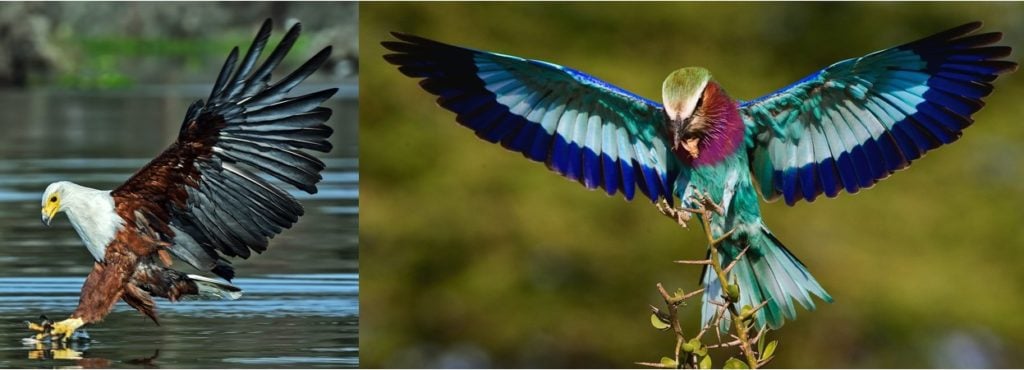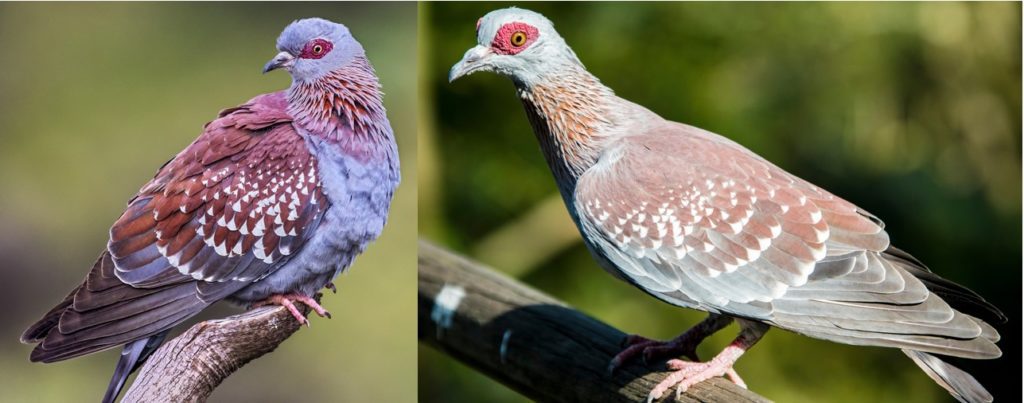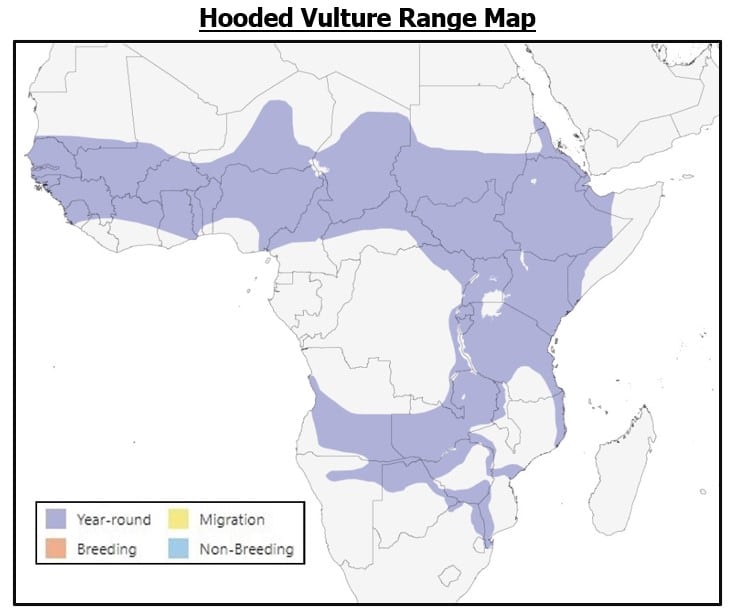15 COMMON Birds Found in Niger! (2025)
Are you trying to identify a bird found in Niger?

Some of the wildest and most colorful birds you could imagine are found here. From gigantic, flightless birds to colorful showstoppers, there’s something to catch everyone’s attention!
Due to the sheer number of species, there was no way to include every bird in Niger in this article. So instead, I tried to focus on the birds that are most regularly seen and observed.
15 COMMON types of birds in Niger!
#1. Abyssinian Roller
- Coracias abyssinicus

Identifying Characteristics:
- Adults are 28–30 cm (11–12 in) long.
- The butterscotch brown back and face contrast sharply with its otherwise brilliant blue plumage.
- They have two unusually long tail feathers that look like streamers in flight.
The Abyssinian Roller is an unmistakably beautiful bird in Niger!
However, its appearance is just one of its many incredible traits. For example, check out their attack pattern, which is how they earned their name. They tumble and roll as they try to catch escaping prey.
Abyssinian Rollers fly through forests decimated by fire, looking for disturbed rodents, snakes, invertebrates, and reptiles to hunt. They’re also aggressive at defending their territory. They juke and somersault, dive-bombing humans or other threats.
Although unrelated to corvids, these flashy birds make a crow-like sound of “GawwwK” or a screechy “Arrrg.” These mimicking sounds are deliberately intimidating, and this fearless species has the personality to back them up. LISTEN BELOW!
#2. African Fish Eagle
- Haliaeetus vocifer

Identifying Characteristics:
- Adults are 63–75 cm (25–29.5 in) long with a wingspan of 2.0-2.4 m (6.6-7.9 ft).
- Their brown bodies contrast with black wings and a white face, chest, and legs. Their beaks and feet are bright yellow.
- This species’ long talons are barbed to aid in picking up fish.
As the most popular bird in Niger, this species is featured on flags of countries across the continent.
The African Fish Eagle symbolizes hope and freedom and is also known as the Screaming Eagle or the African Sea Eagle.
In addition to fish, they eat large birds, frogs, baby crocodiles, and carrion. They’re even known to eat monkeys! Typically, they perch on a branch, then dive down in a graceful swoop to grab their dinner. Additionally, they love to steal prey from other birds for an easy meal on the go.
The African Fish Eagle’s resoundingly clear call is sometimes known as The Spirit of Africa.

This remarkable bird is a habitat generalist, meaning it can live in most climates. Its only true requirement is a large body of water, like a lake or the ocean. So, other than the desert, you can expect to see this bird no matter where you are in Niger!
#3. Beautiful Sunbird
- Cinnyris pulchellus

Identifying Characteristics:
- Adults are 10 cm (4 in) long.
- Males are black on the face and belly, with metallic green on the head, back, and underparts. The chest is a vibrant red, bordered with bright yellow.
- Females are brown, with yellow-brown underparts.
These colorful, flashy birds in Niger feed primarily on nectar, like the hummingbirds of the western hemisphere. They like to feed upside down, hanging from a branch to get to inverted flowers. This position can make them look a little like a traffic light. Beautiful Sunbirds have a tubular tongue with a brush-like tip to aid in nectar collection.
Hotel proprietors often plant their preferred flowers to attract them to entertain visitors. Their vivid coloring and vocal nature make them a true joy to watch!
The Beautiful Sunbird’s song is a chu-chu-chu repeated in triplets or irregular groups and at irregular intervals.
#4. Hadada Ibis
- Bostrychia hagedash

Identifying Characteristics:
- Adults are about 76 cm (30 in) long.
- They are grey overall, with a wash of iridescent green and purple on the wings. The top of the beak and feet are red during the breeding season.
- The beak is long and slightly curved; aside from that, this species has a shape similar to a duck.
Despite its large and relatively round shape, the Hadada Ibis spends much of its time in trees! This species roosts and nests in branches, which can be particularly dangerous for their young. Nestlings frequently fall to their death because the platform is built in a high fork of a tree, and it is flat, with no protective lip to keep the young inside.
Although it’s comfortable in trees, the Hadada Ibis forages for food on the ground. They feed on multitudes of insects and larvae, which is a boon to those who work outside.
For example, gardeners appreciate their visits since they eat snails and don’t damage the plants. Greenskeepers like them too, because they remove moth and beetle larvae that eat the roots of grasses. They also dig up earthworms with their long curved beak.
Its name derives from the sound of its loud call.

#5. Hamerkop
- Scopus umbretta

Identifying Characteristics:
- Adults stand about 56 cm (22 in) tall.
- Brown all over, with a dark brown to black bill and legs.
- This waterbird has an unusual crest, making its head appear elongated toward the back.
You might have seen pictures of the Hamerkop on its favorite perch – the back of a hippopotamus! This water bird likes to hunt from these living platforms, and the hippos don’t seem to mind.
An easy way to identify this bird in Niger is to look for its incredible nest. They build a huge nest (up to two meters tall) in a tree fork, with only a tiny side entrance. The same nest can be used for up to four years unless it is disturbed in some way, which happens more often than you might think.
They’re also rather noisy, cackling and yapping while they hunt and socialize.

#6. Helmeted Guinea Fowl
- Numida meleagris

Identifying Characteristics:
- Adults grow up to 53-58 cm (21-23 in).
- Their coloring is black with white spots. The legs are black, and the featherless head is bright blue with red on the face.
- This species has a large, round body and a very small head and neck.
These chicken-like birds in Niger are capable of flight but only do so when in danger.
Instead, they walk up to 10 kilometers (6 miles) daily in their quest for food. They’ll eat anything from small mammals and lizards to worms, insects, frogs, small snakes, snails, seeds, fruit, and spiders.
Outside breeding season, they form flocks of up to 24 birds and roost communally so they can alert each other to predators. They have an explosive take-off and only flap for short distances, gliding for longer flights. They prefer to flee from predators on land and can run 35 kph (22 mph) on land.
Helmeted Guineafowl have various calls, and some are more pleasant than others. For example, their whistling tune is much nicer on the ears than the raucous and irritating one found here.

#7. Hooded Vulture
- Necrosyrtes monachus

Identifying Characteristics:
- Adults are 62–72 cm (24–28 in) long with a wingspan of 155–180 cm (61–71 in).
- Their plumage is a uniform brown, with a featherless pinkish-white face and a grey-brown “hood” of short feathers.
- This large vulture has an upright posture, large body, and small head, which are typical of its kind.
The Hooded Vulture is more mild-mannered than most other scavengers in Niger.
As a result, it’s developed skills to make sure they can eat before more aggressive vultures chase it off from a carcass. It often arrives first, takes a small meal, and moves on, eating more frequently and in smaller portions.
Another way this species has adapted is to start visiting slaughterhouses and garbage dumps. Here, they take advantage of easy meals. The clever part is that the bigger, more aggressive vultures are not comfortable around humans, so Hooded Vultures avoid conflict.
Despite finding ways to adapt and survive, Hooded Vultures are still considered critically endangered. Often, when poachers kill big game, they remove the valuable parts and then poison the carcass with pesticides. These toxins kill any vultures that come to feed, so rangers won’t see vultures circling the carcasses, and the criminals have more time to get away.
#8. Little Bee-Eater
- Merops pusillus

Identifying Characteristics:
- Adults are 15–17 cm (6-7 in.) long.
- They have a green back, a bright yellow throat, and a black collar. Their bellies are a deeper brownish-yellow.
- This species is slender and upright, with a pointed black beak.
Little Bee-eaters are the smallest species of African bee-eater. These birds are quite tame and friendly. They make practically no sound except for a quietly trilled “s-s-e-e-e-p.”
As their name implies, these little birds subsist on hornets, wasps, and bees. But, they’ve found an efficient way to avoid being stung by their favorite foods. Before they eat them, they smash their prey’s stinger into a hard surface several times to extract it.
Look for groups of Little Bee-eaters lined up, roosting communally on a branch. These tight-knit communities spend time together year-round. For example, a non-breeding pair will help feed chicks and even sit on the eggs to help out. Some nesters can have as many as five helpers raising the nestlings.
#9. Northern Red-Billed Hornbill
- Tockus erythrorhynchus

Identifying Characteristics:
- Adults are 50-60 cm (20-24 in) long.
- These black, white, and gray birds have large, bright red beaks.
- Their tails are long, and they are low to the ground when standing.
Look for Northern Red-billed Hornbills in dry forest habitats. They are ground foragers and omnivores, eating small animals, insects, fruits, and eggs. Although comfortable on the ground, they can also be seen soaring from tree to tree.
If this species looks familiar, it might be that you remember it from a movie! The Northern Red-billed Hornbill was the model for the character Zazu in The Lion King. I don’t think it takes much imagination to see the resemblance. 🙂
#10. Pied Crow
- Corvus albus

Identifying Characteristics:
- Adults are 46-52 cm (18-20 in) long.
- Their coloring is completely black, except for the stark white “vest” between their wings and across their chest.
If you’ve ever wondered about the difference between a crow and a raven, studying the Pied Crow is a good way to learn! This bird in Niger is considered a “link” between the two related families. It has the larger bill and long legs of a raven, as well as wider wings and a longer tail. However, its beak is small and straight like a crow’s, and it also has the typical “caw” call.
Pied Crows are often found near humans, but they don’t interact with people very much. They seem to like villages and towns, probably because of the abundance of food due to human refuse.
They are social and may congregate near an abundance of food but are generally found in pairs or small groups. Pied Crows eat reptiles and mammals, nestlings and eggs, insects and invertebrates, peanuts, grains, carrion, and human trash. If there is a slaughterhouse in the vicinity, you’ll almost certainly find them there, too.
#11. Pied Kingfisher
- Ceryle rudis

Identifying Characteristics:
- Adults grow to 25 cm (10 in) long.
- Their coloring is white, with small black spots on the face, head, wings, tail, and shoulders.
- This species has an extremely long and sharp beak.
Pied Kingfishers are the largest hovering bird in Niger.
They often hover over a body of water, hunting until they spot a likely victim. Then, they drop vertically into the water, grab their prey, and leap out again. In addition, they often eat small prey in flight, allowing them to hunt small insects continuously without the need to return to shore.

Compared with other kingfishers, this species is gregarious and friendly. They often roost together in large groups at night. Pied Kingfishers are nearly always found close to large bodies of water.
#12. Red-Throated Bee Eater
- Merops bulocki

Identifying Characteristics:
- Adults are 20-22 cm (8-9 in) long.
- These birds have a distinct color pattern: green on the wings and head, rusty brown on the belly, with a red throat and deep blue under the tail.
- They have a black streak over the eyes and a long, pointed beak.
Red-throated Bee Eaters are a communal species, nesting in colonies all year round. Like other bee-eaters, they dig a tunnel in a sandy or muddy bank early in the season before the soil dries and solidifies. To create the tunnel, these birds dig with both feet, throwing material behind them like a dog.
They eat small bees, stingless bees, grasshoppers, flying ants, and locusts. To catch a meal, the Red-throated Bee Eater watches from a perch and then plucks an insect out of the air, gobbling it up as it flies.
Their sound is rather penetrating and can be quite startling if you’re not expecting it. Of course, such a tiny bird is not expected to be that loud.
#13. Speckled Pigeon
- Columba guinea

Identifying Characteristics:
- Adults grow up to 41 cm (16 in) long.
- Their coloring is slate gray overall, with rusty wings and white tips on the flight feathers.
- They have a ring of red skin around the eye, giving them a wide-eyed look.
It’s not uncommon for hundreds of Speckled Pigeons to form a flock and inhabit the exterior of large human structures. They’re the primary food source for birds of prey that live in large cities.
Although their shape and behavior are similar to typical urban rock pigeons, Speckled Pigeons are much larger. This species is the largest pigeon in Niger at nearly 41 cm (16 inches) long.
Even if the Speckled Pigeon’s call is understated and melodic, it can be overwhelming when hundreds are singing at once. It sounds like “OooOOOuu” repeated a dozen times or more in a row.

#14. Village Weaver
- Ploceus cucullatus

Identifying Characteristics:
- Adults are 15–17 cm (6-7 in) long.
- Males have a black face with a bright red eye, a bright yellow chest, a brown cowl down the back of the head, and splotchy black and yellow wings.
- Females are largely yellow (including the head), with pale olive stripes on the upper parts and buff-yellow chest and underparts.
The Village Weaver has some of the most interesting nesting habits of any bird in Niger.
For one, the nests themselves look like Christmas ornaments! They’re woven balls of grass and feathers that hang from the branches of trees. Additionally, male Village Weavers build the nests alone and defend them to attract a mate. Think of this as showing off your big, new house to your date!
Once a female chooses a nest (and a mate), she fills it with bedding and lays her eggs. Then, the male finds another mate and begins the process again! Despite having up to five broods at a time, the male Village Weaver contributes to the feeding and care of all his hatchlings.
These communal birds can be quite noisy, as they spend most of their time in their nests calling to one another.

#15. White-backed Vulture
- Gyps africanus

Identifying Characteristics:
- Adults are 78-98 cm (31-39 in) long and have a 1.96-2.25 m (6-7 ft) wingspan.
- Its coloring is muted brown, except for its off-white back. The face and wings are darker brown than the body.
- This species has a bald face and short, downy feathers on the head and neck.
This species has seen the most rapid decline of any bird in Niger.
Its conservation status has gone from Least Concern to Critically Endangered in just fifteen years. Power lines, poisoned carrion, pesticides, and poaching are also contributing factors.
Part of the reason for their decline is that White-backed Vultures are very tame and will happily wander into town to look for food. Unfortunately, it’s vulnerable to kidney failure due to poisoning from diclofenac, a drug widely used by humans for pain, inflammation, arthritis, and gout.
In addition to diclofenac poisoning, fires have recently eliminated much of their breeding territory, adding to the decline. Their extremely long breeding cycle is another strain on their population. White-backed Vultures have to incubate their eggs for two months and care for nestlings for four to five months.
Do you need help identifying birds in Africa?
These books will provide you with much more information!
Which of these birds in Niger have you seen before?
Leave a comment below!
















